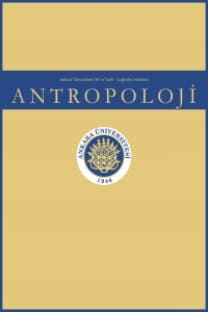THE MANY FACES OF FU MANCHU:WHITE EXPATRIATE COMMUNITY IN TAIWANAND THE GENEALOGY OF A RACISTSTEREOTYPE
THE MANY FACES OF FU MANCHU:WHITE EXPATRIATE COMMUNITY IN TAIWANAND THE GENEALOGY OF A RACISTSTEREOTYPE
This study is the product of a four-year-long fieldwork in Taiwan. During that time,I examined the racist stereotypes of white, western people living in Taiwan on thenatives. I compared the data I gathered from the field work with the Chinese stereotypethat is prevalent in the popular culture. The results show the importance ofracist generalization in white westerners’ self-perception. The character called FuManchu, which emerges in various different media since 1913, appears to be animportant means in measuring these changing perceptions.Fu Manchu’s fear factor is formed after the character’s way of expressing its sexualitywhen it was first created. In the western world after the “sexual revolution” in60s, Fu Manchu is depicted scary because of the repression of its own sexuality.This research associates the philosophical causes of this change with the contradictionsin Freud’s corpus. It also shows the importance of gender roles in the formationof whiteness.The white mob describes their opposite Chinese, and therefore Fu Manchu, deviantwhen they want to perceive themselves as sexually purified, chaste and virgin. Lateron, when they want to create themselves from scratch as individuals who liberatedtheir sexuality, Fu Manchu is once more devised as a symbol of malignancy whorepresses its sexuality. The fieldwork during the research shows how this fluctuationappears in the daily lives of whites living in Taiwan.
___
- Altman, D.(2002). Global sex. University of Chicago Press.
- Benshoff, H. M. (1997). Monsters in the Closet: Homosexuality and the Horror Film. Manchester: Manchester University Press
- Bhaba, H. (1983). The Other Question. Screen,24(6), 18-36.
- Black, J. (2005). The Politics of James Bond: From Flemming’s Novels to the Big Screen. Lincoln: University of Nebraska Press.
- Bonilla-Silva, E. (2017). Racism without racists: Color-blind racism and the persistence of racial inequality in America. Rowman & Littlefield.
- Chen, A. (2 August 2012). The monstering of swimmer Ye Shiwen says much about declining superpowers.The Guardian. (Last accessed on: June 12th, 2018, https://www.theguardian.com/commentisfree/2012/aug/02/swimmer-yeshiwen- declining-superpowers)
- Chin, T. (1988). Daughter of Shanghai. Reading:Corgi.
- Chun, A.(2010). “5 Nomadic ethnoscapes in the changing global–local pop music industry”. Popular Culture in Taiwan: Charismatic Modernity.M. L. Moskowitz (Ed.), pp. 86, Routledge.
- Dabhoiwala, F.(2012). The origins of sex: A history of the first sexual revolution. Oxford University Press.
- Densmore, D. (1973). “Independence from the sexual revolution”.Radical feminism. A. Koedt, E. Levine and A. Rapone (Eds.), pp. 107-118, Quadrangle/The New York Times Book Company.
- Douglas, M. (2003). Purity and danger: An analysis of concepts of pollution and taboo. Routledge
- Farrer, J. and Field, A. D.(2015). Shanghai nightscapes: A nocturnal biography of a global city. University of Chicago Press.
- Foucault, M. (1990). The history of sexuality: An introduction, Volume I. Robert Hurley (Trans.). New York: Vintage.
- Frayling, C. (2014). The Yellow Peril: Dr. Fu Manchu & the Rise of Chinaphobia. [ebook], Thames & Hudson.
- Eng, D.L. (2001). Racial castration: managing masculinity in Asian America. Duke University Press.
- Freud, S. (2001). Totem and Taboo. James Strachey (Trans.). [ebook] Routledge.
- Freud, S. (1961). Civilisation and it’s discontents. James Strachey (Trans.). New York: W.W Norton & Company Inc.
- Giddens, A.(2013). The transformation of intimacy: Sexuality, love and eroticism in modern societies. John Wiley & Sons.
- Gould, S. Jay. (2006). The Mismeasure of Man. [ebook] W.W Norton.
- Hanser, A. (2012). Yellow peril consumerism: China, North America, and an era of global trade. Ethnic and Racial Studies,36(4), 632-650.
- Ho, J. (2005). “From Anti-Trafficking to Social Discipline”. Trafficking and prostitution reconsidered: New perspectives on migration, sex work, and human rights, K. Kempadoo, J. Sanghera, and B. Pattanaik (Eds.), pp. 83-106.
- Hyam, R. (1990). Empire and sexuality: the British experience. Manchester University Press.
- Jackson, M. (1989). ”‘Facts of Life’ or the Eroticization of Women’s Oppression? Sexology and the Social Construction of Heterosexuality”. The Cultural Construction of Sexuality. P. Caplan (Ed.), pp. 52-81, London: Routledge.
- Kelsky, K.(2001). Women on the verge: Japanese women, Western dreams. Duke University Press.
- Lan, P. C.(2011). White privilege, language capital and cultural ghettoisation: Western high-skilled migrants in Taiwan. Journal of Ethnic and Migration Studies, 37(10), 1669-1693.
- Laqueur, T. W.(1990). Making sex: Body and gender from the Greeks to Freud. Harvard University Press.
- Latour, B. (2012). We have never been modern. Harvard University Press.
- Maher, K. H. and Lafferty, M.(2014). White migrant masculinities in Thailand and the paradoxes of Western privilege. Social & Cultural Geography, 15(4), 427- 448.
- .Mayer, R. (2013). Serial Fu Manchu: The Chinese supervillain and the spread of yellow peril ideology. Temple University Press.
- McVeigh, B. (2000). How Hello Kitty Commodifies the Cute, Cool and Camp ‘Consumutopia’ versus ‘Control’ in Japan. Journal of Material Culture, 5(2), 225-245.
- Miller, D.(2013). A Theory of Shopping. John Wiley & Sons.
- Obeyesekere, G. (1997). The apotheosis of Captain Cook: European mythmaking in the Pacific. Princeton University Press.
- Rohmer, S.(2001). The Insidious Dr. Fu-Manchu. iUniverse, Vancouver
- Seabrook, J. (2001).Travels in the skin trade: Tourism and the sex industry. Pluto Press.
- Stoler, A. L. (2010). Race and the Education of Desire: Foucault’s History of Sexuality and the Colonial Order of things. University of California Press.
- Strathern, M.(1988). The gender of the gift: problems with women and problems with society in Melanesia (Vol. 6). University of California Press.
- Taussig, M. T.(2010). The devil and commodity fetishism in South America. University of North Carolina Press.
- Towers, H. A. (2013). Mr. Towers of London: A Life in Show business. London:BearManor Media.
- Weeks, J.(2007). The world we have won: The remaking of erotic and intimate life. Routledge.
- Wood, S. P.(2010). “‘CHOU GAGS CRITICS IN BANDOENG’ or How the Media Framed Premier Zhou Enlai at the Bandung Conference, 1955.” Modern Asian Studies, 44(5), 1001-1027.
- ISSN: 0378-2891
- Yayın Aralığı: 2
- Başlangıç: 1963
- Yayıncı: Ankara Üniversitesi Basımevi
